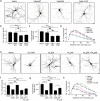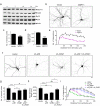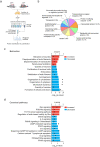p39-associated Cdk5 activity regulates dendritic morphogenesis
- PMID: 33127972
- PMCID: PMC7603351
- DOI: 10.1038/s41598-020-75264-6
p39-associated Cdk5 activity regulates dendritic morphogenesis
Abstract
Dendrites, branched structures extending from neuronal cell soma, are specialized for processing information from other neurons. The morphogenesis of dendritic structures is spatiotemporally regulated by well-orchestrated signaling cascades. Dysregulation of these processes impacts the wiring of neuronal circuit and efficacy of neurotransmission, which contribute to the pathogeneses of neurological disorders. While Cdk5 (cyclin-dependent kinase 5) plays a critical role in neuronal dendritic development, its underlying molecular control is not fully understood. In this study, we show that p39, one of the two neuronal Cdk5 activators, is a key regulator of dendritic morphogenesis. Pyramidal neurons deficient in p39 exhibit aberrant dendritic morphology characterized by shorter length and reduced arborization, which is comparable to dendrites in Cdk5-deficient neurons. RNA sequencing analysis shows that the adaptor protein, WDFY1 (WD repeat and FYVE domain-containing 1), acts downstream of Cdk5/p39 to regulate dendritic morphogenesis. While WDFY1 is elevated in p39-deficient neurons, suppressing its expression rescues the impaired dendritic arborization. Further phosphoproteomic analysis suggests that Cdk5/p39 mediates dendritic morphogenesis by modulating various downstream signaling pathways, including PI3K/Akt-, cAMP-, or small GTPase-mediated signaling transduction pathways, thereby regulating cytoskeletal organization, protein synthesis, and protein trafficking.
Conflict of interest statement
The authors declare no competing interests.
Figures





Similar articles
-
p39 Is Responsible for Increasing Cdk5 Activity during Postnatal Neuron Differentiation and Governs Neuronal Network Formation and Epileptic Responses.J Neurosci. 2016 Nov 2;36(44):11283-11294. doi: 10.1523/JNEUROSCI.1155-16.2016. J Neurosci. 2016. PMID: 27807169 Free PMC article.
-
p39, the primary activator for cyclin-dependent kinase 5 (Cdk5) in oligodendroglia, is essential for oligodendroglia differentiation and myelin repair.J Biol Chem. 2013 Jun 21;288(25):18047-57. doi: 10.1074/jbc.M113.453688. Epub 2013 May 3. J Biol Chem. 2013. PMID: 23645679 Free PMC article.
-
Peripheral and orofacial pain sensation is unaffected by the loss of p39.Mol Pain. 2017 Jan-Dec;13:1744806917737205. doi: 10.1177/1744806917737205. Mol Pain. 2017. PMID: 28969475 Free PMC article.
-
The regulation of cyclin-dependent kinase 5 activity through the metabolism of p35 or p39 Cdk5 activator.Neurosignals. 2003 Sep-Oct;12(4-5):221-9. doi: 10.1159/000074624. Neurosignals. 2003. PMID: 14673209 Review.
-
Recent advances in understanding the roles of Cdk5 in synaptic plasticity.Biochim Biophys Acta. 2009 Aug;1792(8):741-5. doi: 10.1016/j.bbadis.2009.05.001. Epub 2009 May 13. Biochim Biophys Acta. 2009. PMID: 19442718 Review.
Cited by
-
The nutrient-responsive CDK Pho85 primes the Sch9 kinase for its activation by TORC1.PLoS Genet. 2023 Feb 15;19(2):e1010641. doi: 10.1371/journal.pgen.1010641. eCollection 2023 Feb. PLoS Genet. 2023. PMID: 36791155 Free PMC article.
-
Valproic Acid-Induced Anxiety and Depression Behaviors are Ameliorated in p39 Cdk5 Activator-Deficient Mice.Neurochem Res. 2022 Sep;47(9):2773-2779. doi: 10.1007/s11064-022-03642-9. Epub 2022 Jun 8. Neurochem Res. 2022. PMID: 35674931
-
RGC-32 Acts as a Hub to Regulate the Transcriptomic Changes Associated With Astrocyte Development and Reactive Astrocytosis.Front Immunol. 2021 Jul 29;12:705308. doi: 10.3389/fimmu.2021.705308. eCollection 2021. Front Immunol. 2021. PMID: 34394104 Free PMC article.
-
Three decades of Cdk5.J Biomed Sci. 2021 Nov 23;28(1):79. doi: 10.1186/s12929-021-00774-y. J Biomed Sci. 2021. PMID: 34814918 Free PMC article. Review.
-
S-Nitrosylation of p39 promotes its degradation and contributes to synaptic dysfunction induced by β-amyloid peptide.Commun Biol. 2024 Sep 10;7(1):1113. doi: 10.1038/s42003-024-06832-z. Commun Biol. 2024. PMID: 39256547 Free PMC article.
References
Publication types
MeSH terms
Substances
LinkOut - more resources
Full Text Sources
Molecular Biology Databases

